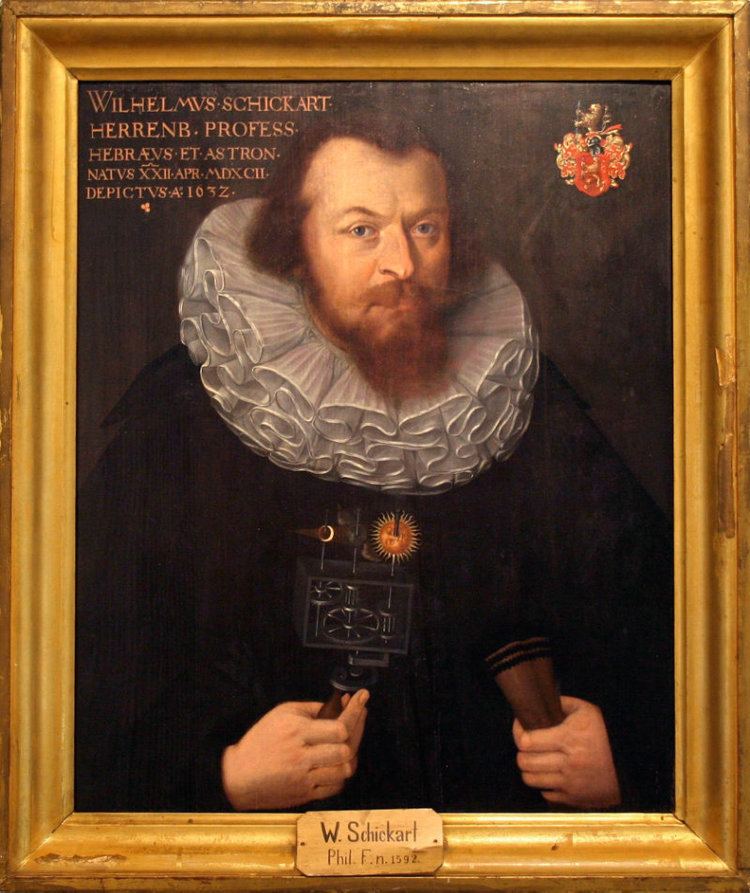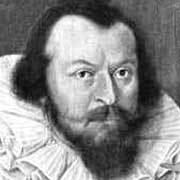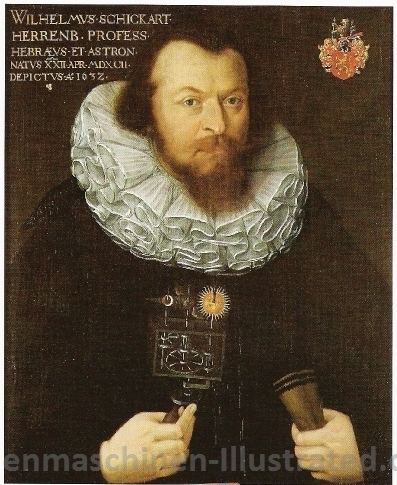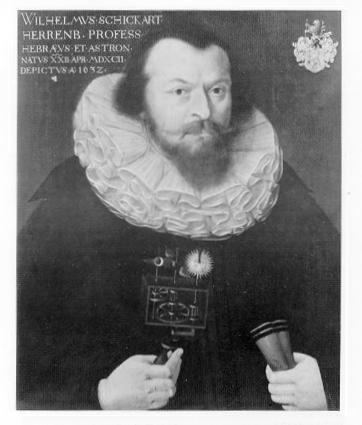Name Wilhelm Schickard Role Biographer | Education University of Tubingen | |
 | ||
Died October 24, 1635, Tubingen, Germany Similar People Charles Babbage, John Napier, Gottfried Wilhelm Leibniz, Konrad Zuse, Blaise Pascal | ||
Wilhelm schickards rechenmaschine
Wilhelm Schickard (22 April 1592 – 24 October 1635) was a German professor of Hebrew and Astronomy who became famous in the second part of the 20th century after Dr. Franz Hammer, a biographer (along with Max Caspar) of Johannes Kepler, claimed that the drawings of a calculating clock, predating the public release of Pascal's calculator by twenty years, had been discovered in two unknown letters written by Schickard to Johannes Kepler in 1623 and 1624.
Contents
- Wilhelm schickards rechenmaschine
- April 22 giuseppe torelli charles mingus wilhelm schickard
- Life
- Political theory
- History
- Schickards drawing had been publicly known since 1718
- The surviving notes do not describe a fully functional machine
- References

Dr. Hammer asserted that because these letters had been lost for three hundred years, Blaise Pascal had been called and celebrated as the inventor of the mechanical calculator in error during all this time.

After careful examination it was found that Schikard's drawings had been published at least once per century starting from 1718, that his machine was not complete and required additional wheels and springs and that it was designed around a single tooth carry mechanism that didn't work properly when used in calculating clocks.

Schickard's machine was the first of several designs of direct entry calculating machines in the 17th century (including the designs of Blaise Pascal, Tito Burattini, Samuel Morland and René Grillet). The Schickard machine was particularly notable for its integration of an ingenious system of rotated Napier's rods for multiplication with a first known design for an adding machine, operated by rotating knobs for input, and with a register of rotated numbers showing in windows for output. Taton has argued that Schickard's work had no impact on the development of mechanical calculators. However, whilst there can be debate about what constitutes a "mechanical calculator" later devices, such as Moreland's multiplying and adding instruments when used together, Caspar Schott's Cistula, René Grillet's machine arithmétique, and Claude Perrault's rhabdologique at the end of the century, and later, the Bamberger Omega developed in the early 20th Century, certainly followed the same path pioneered by Schickard with his ground breaking combination of a form of Napier's rods and adding machine designed to assist multiplication. He is considered as the 'father of computing age'.
April 22 giuseppe torelli charles mingus wilhelm schickard
Life
Schickard was born in Herrenberg and educated at the University of Tübingen, receiving his first degree, B.A. in 1609 and M.A. in 1611. He studied theology and oriental languages at Tübingen until 1613. In 1613 he became a Lutheran minister continuing his work with the church until 1619 when he was appointed professor of Hebrew at the University of Tübingen.
Schickard was a universal scientist and taught biblical languages such as Aramaic as well as Hebrew at Tübingen. In 1631 he was appointed professor of astronomy at the University of Tübingen. His research was broad and included astronomy, mathematics and surveying. He invented many machines such as one for calculating astronomical dates and one for Hebrew grammar. He made significant advances in mapmaking, producing maps that were far more accurate than previously available.
He was, among his other skills, a renowned wood and copperplate engraver.
Wilhelm Schickard died of the bubonic plague in Tübingen, on 23 or 24 October 1635. In 1651, Giovanni Riccioli named the lunar crater Schickard after him.
Political theory
In 1625 Schickard, a Christian Hebraist, published an influential treatise, Mishpat ha-melek, Jus regium Hebraeorum (Title in both Hebrew and Latin: The King's Law) in which he uses the Talmud and rabbinical literature to analyze ancient Hebrew political theory. Schickard argues that the Bible supports monarchy.
History
In 1623 and 1624, Wilhelm Schickard, in two letters that he sent to Kepler, reported his design and construction of what he referred to as an “arithmeticum organum” (“arithmetical instrument”) that he has invented, but which would later be described as a Rechenuhr (calculating clock). The machine was designed to assist in all the four basic functions of arithmetic (addition, subtraction, multiplication and division). Amongst its uses, Schickard suggested it would help in the laborious task of calculating astronomical tables. The machine could add and subtract six-digit numbers, and indicated an overflow of this capacity by ringing a bell. The adding machine in the base was primarily provided to assist in the difficult task of adding or multiplying two multi-digit numbers. To this end an ingenious arrangement of rotatable Napier's bones were mounted on it. It even had an additional "memory register" to record intermediate calculations. Whilst Schickard noted that the adding machine was working his letters mention that he had asked a professional, a clockmaker named Johann Pfister to build a finished machine. Regrettably it was destroyed in a fire either whilst still incomplete, or in any case before delivery. Schickard abandoned his project soon after. He and his entire family were wiped out in 1635 by bubonic plague during the Thirty Years' War.
Incidentally, Kepler used another one of Napier's inventions for his calculations (much more appropriate for computing planets' orbits than his Napier's bones): the logarithm tables; Because of this, Kepler dedicated his Ephemeris to John Napier.
Max Caspar, one of Kepler's biographer, physically found these two letters in 1935 and later. Extrapolating from these findings, Dr. Franz Hammer, another one of Kepler's biographers, challenged in 1957 the fact that Pascal had invented the mechanical calculator by announcing to the world that the drawings of this previously unknown calculating clock, predating Pascal's work by twenty years, had been found in these two letters. Bruno von Freytag-Löringhoff, a professor of philosophy specialized in logic at the University of Tübingen, built the first replica of this machine in 1960. Dr. Hammer claimed that Blaise Pascal wouldn't have been considered the inventor of the mechanical calculator for three centuries had the world known of Schickard's forgotten machine.
Schickard's drawing had been publicly known since 1718
In 1718 one of the first biographers of Kepler—the german Michael Gottlieb Hansch (1683-1749), published a book of letters of Kepler, which includes the two letters from Schickard to Kepler. There is even a marginal note of the publisher Schickardi machina arithmetica at the second letter, obviously on the calculating machine.
In 1899 in the Stuttgart's surveying magazine Stuttgarter Zeitschrift für Vermessungswesen was published an old article for the topography in Württemberg, Germany, written many years ago and probably published in other editions, by German scientist Johann Gottlieb Friedrich von Bohnenberger (1765–1831). In this article the name of Schickard is mentioned several times, not only concerning his important contribution in the field of topography, but it is mentioned also that ...it is strange, that nobody admitted, that Schickard invented a calculating machine. In 1624 he ordered a copy for Kepler, but it was destroyed in a night fire. Bohnenberger (known mainly as the inventor of the gyroscope effect), just like Schickard, studied and later was appointed a professor of mathematics and astronomy at the University of Tübingen since 1798.
Nachrichten des Württembergischen Vermessungstechnischen VereinsWürttembergischen LandesbibliothekThe surviving notes do not describe a fully functional machine
Pdof. Dr. von Freytag-Löringhoff, a professor of philosophy specialized in logic at the University of Tübingen built the first replica of Schickard's machine in 1960 but he had to improve on the design of the carry mechanism:
This simple-looking device actually presents a host of problems to anyone attempting to construct an adding machine based on this principle. The major problem is caused by the fact that the single tooth must enter into the teeth of the intermediate wheel, rotate it 36 degrees (one tenth of a revolution), and exit from the teeth, all while only rotating 36 degrees itself. The most elementary solution to this problem consists of the intermediate wheel being, in effect, two different gears, one with long and one with short teeth together with a spring-loaded detente (much like the pointer used on the big wheel of the gambling game generally known as Crown and Anchor) which would allow the gears to stop only in specific locations. It is not known if Schickard used this mechanism, but it certainly works well on the reproductions constructed by von Freytag Loringhoff.
This does not of course tell us whether or not the machine that Schickard actually built worked, as he described to Kepler, or still had problems. The role of a détente is not described in the two surviving Schickard's letters and drawings but as these were merely notes this cannot be taken to mean that he was misleading Kepler when he stated that he had built such a machine and it worked. The role of a détente catchment was widely understood by clockmakers, and as Schickard had turned to clockmakers to construct his machine, it is highly likely that this type of approach would have been included before the finalisation of his machine.
A problem in the operation of the Schickard machine, based on the surviving notes, was found after the replicas were built:
... it is almost certain that Pascal would not have known of Schickard's machine ...
Pascal seems to have realized right from the start that the single-tooth gear, like that used by Schickard, would not do for a general carry mechanism. The single-tooth gear works fine if the carry is only going to be propagated a few places but, if the carry has to be propagated several places along the accumulator, the force needed to operate the machine would be of such magnitude that it would do damage to the delicate gear works.
Schickard's machine used clock wheels which were made stronger and were therefore heavier, to prevent them from being damaged by the force of an operator input. Each digit used a display wheel, an input wheel and an intermediate wheel. During a carry transfer all these wheels meshed with the wheels of the digit receiving the carry. The cumulative friction and inertia of all these wheels could "...potentially damage the machine if a carry needed to be propagated through the digits, for example like adding 1 to a number like 9,999".
Even though Schickard designed his machine twenty years earlier a controversy continues as to whether Schickard or Pascal should be described as the inventor of the mechanical calculator. On the one hand, we have from Schickard's drawings the first description of a mechanical calculator. But the carry mechanism of Schickard's calculator is not fully described (which does not necessarily mean there was not one well worked out) and from what is described in the surviving notes it appears that if a carry was required across several places simultaneously the mechanism would jam. On the other hand, examples of Pascal's calculator survive and modern replicas have been made which work perfectly. But Pascal designed and built his machines later than Schickard. In the end, the answer to the question of who should be recognised as having primacy in this invention depends on precisely how that question is phrased.
The debate over the primacy of Schickard or Pascal's calculating inventions is dealt with more comprehensively in Schickard versus Pascal: An Empty Debate? Here it is sufficient to note that the two machines were essentially different in that Pascal's machine was designed primarily for addition and (with the use of complementary numbers) for subtraction. The adding machine in Schickard's design may have jammed in the unusual case of a carry being required across too many dials, but it could smoothly subtract by reversing the motion of the input dials, in a way that was not possible in the Pascaline. (Experiments with replicas show that in the event of a jam when a carry is attempted across more than (say) three dials, it is obvious to the operator who may intervene to assist the machine to perform the additional carries. This is not as efficient as with the Pascaline, but it is not a fatal deficiency.) The Schickard adding machine also has provision for an audible warning when an output was too large for the available dials. This was not provided for in the Pascaline.
In any case, in contradistinction to the aims of Pascal—which appear to have been to create a smoothly functioning adding machine for use by his father initially, and later for commercialisation—the adding machine in Schickard's design appears to have been introduced to assist the grander objective of multiplication (through the calculation of partial products using Napier's rods, a process that can also be used to assist division). Experiments with building modern replicas of either machine suggest that there were things that in practice could interfere with the smooth performance of either the Pascaline or the adding machine in Schickard's design. Modern replicas of the Pascaline (when constructed with similar materials and technique to the originals) demonstrate that with some additional tweaks it can work perfectly for addition with careful adjustment and operation. But it does not take much to throw it into less than perfect performance. The Schickard could resist carry over to too many output wheels at once, and when this occurred would need to be assisted by the operator to complete the carry. So it depends on what is considered as important as to whether either machine could be seen as a success or failure. Neither, was a success in the sense that it was taken up and used widely in practice. From what is known neither can be shown to be a failure in the sense that it could not be used by a careful operator to calculate in one way or another. For this reason, and given the ongoing debate on how most felicitously to characterise the matter in the scholarly literature, attempting to produce an artificial closure on this debate is probably unproductive.
The Institute for Computer Science at the University of Tübingen is called the Wilhelm-Schickard-Institut für Informatik in his honor.
